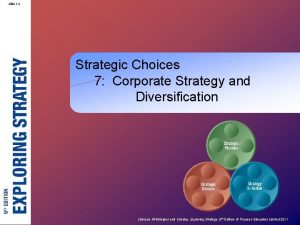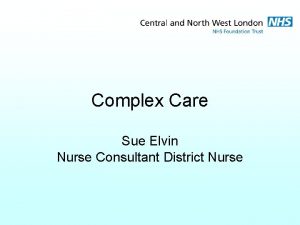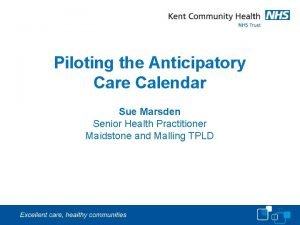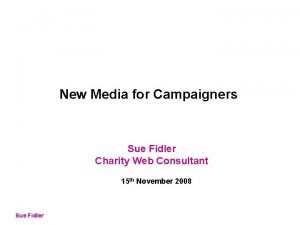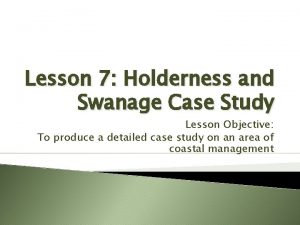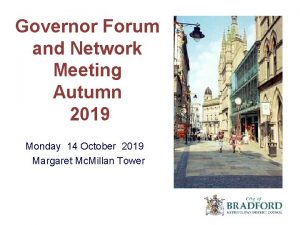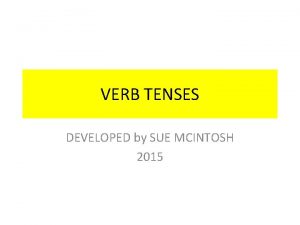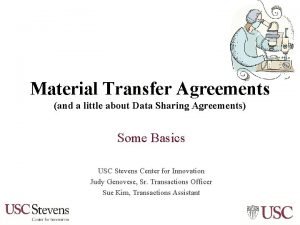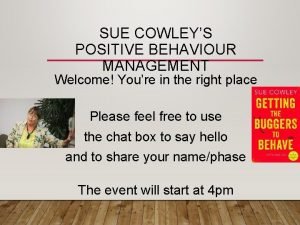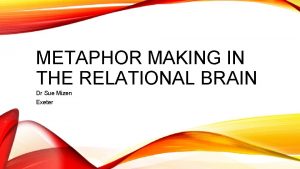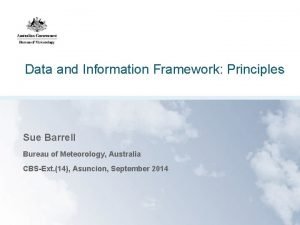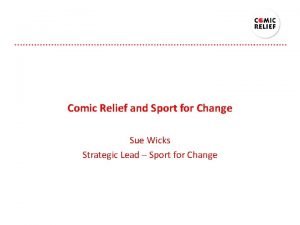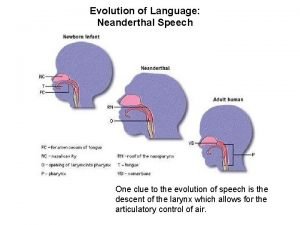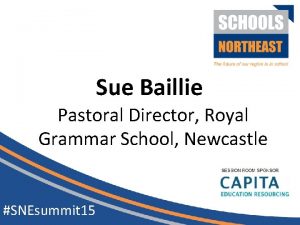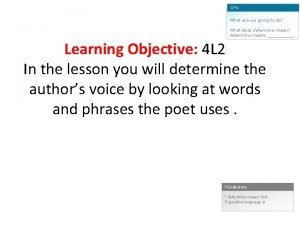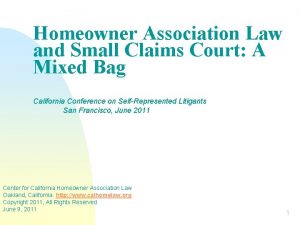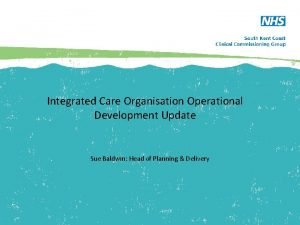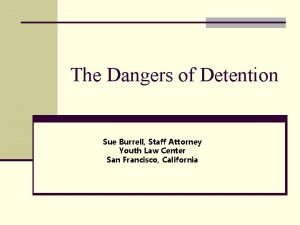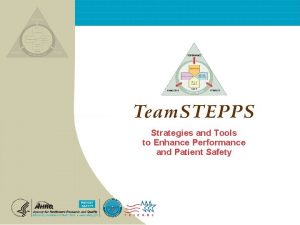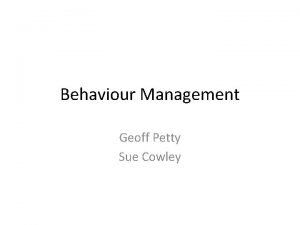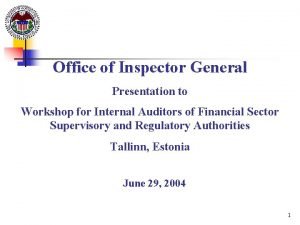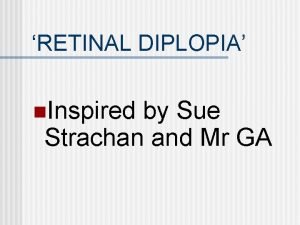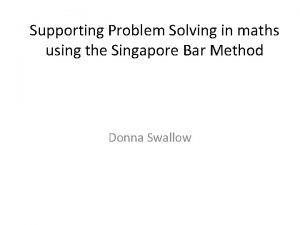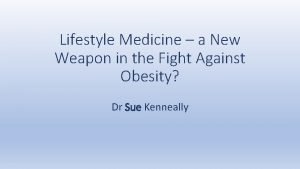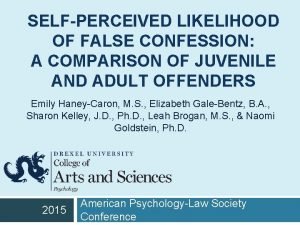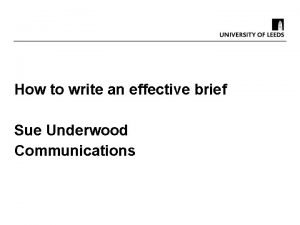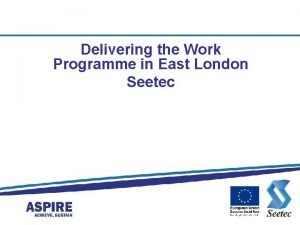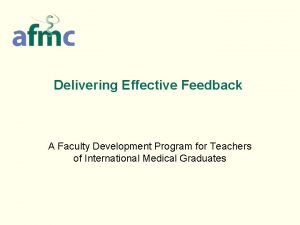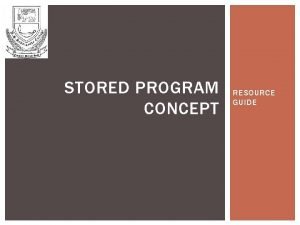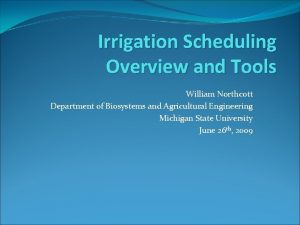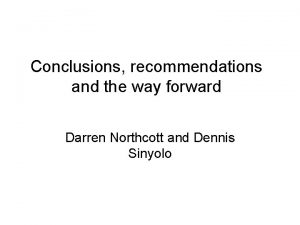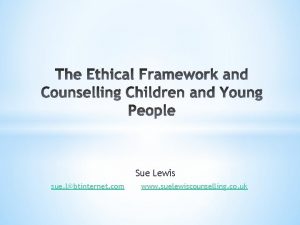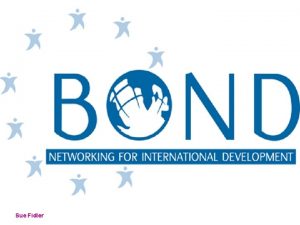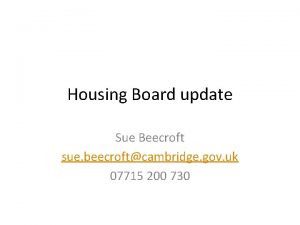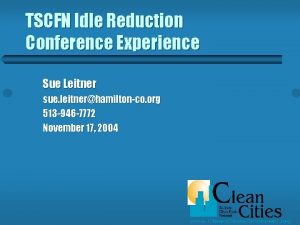Sue Northcott A welcome from WYFIs Programme Manager



























































































- Slides: 91


Sue Northcott A welcome from WY-FI’s Programme Manager

A welcome from The WY-FI Network - Heidi Kite WY-FI Peer Mentor and Network Member

Mark Burns-Williamson West Yorkshire Police and Crime Commissioner

Anna Headley Humankind (WY-FI Lead Partner) and Chair, Core Partner Management Board

The numbers … 731 beneficiary starts (aiming for 1050 by 2020) 306 currently on caseloads 11 beneficiaries now involved in the network 158 people undertaking 222 places on training 104 completed CERTA level 2 in Peer Mentoring

The Central Pillars • Navigation Model • Multi-Agency Review Board (MARB) • Peer Mentors • Personalisation Fund • Employment, Training and Education

WY-FI Legacy …

Del Roy Fletcher Professor of Labour Market Studies, BSc (Hons) MSoc Sc Centre for Regional Economic and Social Research at Sheffield Hallam University

The Evaluation of WY-FI: Key Lessons & Reflections Year 4 Annual Conference: Leeds Civic Hall Professor Del Roy Fletcher September 26 th 2018

Outline • Aim: Share some of the learning and knowledge emanating from the local evaluation of WY-FI. • Context: Fulfilling Lives Programme & WY-FI. • Operating Environment • Evaluation. • Focus: two key elements of the delivery model: Navigators; Multi-Agency Review Boards (MARBs). • Outline latest findings re: impact on service costs. • Conclusions and reflections.

Context • Fulfilling Lives Programme: BLF invested £ 112 m in 12 areas of England to improve the lives of people with multiple and complex needs. Economic rationale pre-eminent: group increasingly prioritised because they make a significant call on public resources. Financial benefits accrue from improving way services are co-ordinated and delivered. • WY-FI: focuses on adults with at least three needs (homelessness, reoffending, problematic substance misuse and mental ill-health). Seeks to joinup existing provision for 1, 050 individuals over 6 years across West Yorkshire. Tailor packages of support. • Guiding principles: co-production, working in an asset-based and personcentred way, fostering multi-agency working.

Challenging Operating Environment • Growing need: Homelessness in all its forms increased. Prison population risen by >90% 1990 -2015. Prison overcrowding & staff reductions led to highest number of prison deaths, homicides and rates of self-harm on record (Prison Reform Trust, 2016). Prison: warehousing the most vulnerable? • Policy changes: – Transforming Rehabilitation: Replaced Probation Trusts with a National Probation Service and Community Rehabilitation Companies. HMIP (2017) found that CRCs not commissioning the range of specialist services that are needed, staff have exceptional workloads, and the national delivery model does not have at its heart effective joined-up local partnership work. – Welfare Reforms: Since mid-1980 s eligibility for benefits tightened and dramatic increase in the severity and use of benefit sanctions. Extended sanctioning period from six weeks from 1911 to 1986 to 3 years in 2012: 'most punitive welfare sanctions ever proposed by a British Government'. Vulnerable groups disproportionately affected. Universal Credit: requires bank account and computer literacy. – Austerity: service cuts and growing pressure on the front-line ('doing more with less') compromised ability of providers to provide depth of support needed by client group.

Evaluation • Evaluation: process (explore changes to service delivery and how experienced) and impact (on service costs). • Ongoing fieldwork with six sets of respondents: – Regional Support Hub staff – Delivery partners and wider stakeholders – MARB staff – Navigator teams – Beneficiaries – 'Experts by experience' and Peer Mentors

Navigators • Approach: befriend individuals, accompany them to interviews and 'fight their corner' to ensure services are delivered in a personalised and flexible fashion. • Small caseloads and freedom to work with individuals over long time. • Client-led approach combined with tangible help (Personalisation Fund).

What we have learnt? • It takes time to establish relationships of trust. This reflects depth of beneficiary vulnerabilities and their problematic history of service use: 'I was absolutely flat on the floor. . I've been there loads of times and the more you're on the floor the more that your problems are a mountain and you don't want to face them. You give up and you've nowt to live for'. • Navigators with lived experience have the advantage of shared histories and experiences. Act as role models- a living embodiment that change is possible. But for some familiarity with the same 'world' and potentially the same people is a concern. • Navigators have become involved in long-term intensive relationships and provide emotional and practical support: 'taking the everyday stresses away'. • A key advantage of the navigator relationship is its reliability and longevity: 'I always know she is there'.

Further Lessons • Personality of the navigators and 'people skills' are crucial (humour and being personable). Beneficiaries frequently liken strong relationships to 'friendships'. • Positive behavioural change often results from the relationship itself. : 'I feel I've got someone who genuinely cares'. Relationship drawn upon to cope in times of crisis: 'It's the first time in my life that I've had people that are there that are to help me and support me when I'm falling apart'. • Size of the teams matter: larger teams provide more scope to conduct outreach (street presence), broker effective matches between navigators and beneficiaries; comprise a range of expertise; pool learning and build resilience within teams. • Navigators need support: experience rejection, deal with challenging behaviour and deaths. Teams have had to consider how best to provide ongoing support to navigators.

Multi-Agency Working • MARBs play a pivotal role in facilitating multi-agency case conferencing and joining up local support. • MARBs are resource intensive but have engaged all four areas of support following initial difficulties with mental health providers. CRCs have been difficult to engage. • Represented a new departure in some districts (Calderdale) whereas there was a pre-existing commitment to multi-agency working in Bradford and Leeds: 'add value'. • MARBs have been instrumental in facilitating 'service flex', getting to providers to reconsider those banned from provision and refocussing support on the most vulnerable. • Engineered a step change in working relationships: MARBs are 'glue that holds the approach together'.

What have we learnt? • MARBs have opened up pathways into other services and support (e. g. housing or social workers) and allowed WY-FI to challenge providers about the exclusion of clients from services and 'ask difficult questions'. • MARBs have begun to engender cultural change: 'advocate from the inside' to ensure a quicker and more flexible approach to working with people with multiple and complex needs. • MARBs evolved differently: Some remained small; others grown rapidly in terms of scale and remit and have become pre-eminent (Bradford, Leeds). Leeds has 'vulnerable women', rough sleeper section and incorporating integrated offender management. 'It's turned into a big, complex needs meeting where everybody comes and talks about complex needs in Leeds which is brilliant. . all the agencies are in the room'. • Success factors: effective & efficient chair (create right environment moves beyond talking shop: 'I'll go and shake their hand say who are you and welcome before meeting starts'); the involvement of the 'right' partner agencies; the seniority of attendees (with power to flex services) and opportunity for face-to-face contact.

Impact on Service Costs • CRESR developed a costing model to quantify extent to which WY-FI has affected costs of service use. • Model is based on service use data across 18 areas for 190 service users across five quarters. Results are then scaled-up to the expected 1, 050 beneficiaries. • Results will be improved as more service users are included and it is able to cover a longer time horizon. • More positive impacts on service costs will occur over longer time horizons. • Predicted that WY-FI has increased service costs by £ 3. 4 million or approximately £ 3, 300 per service user. Table 1 shows that it is predicted to reduce costs for nine negative 'reactive' events e. g. crown court proceedings, evictions and arrests. Cost rises for those experiencing 'treatment' e. g. mental health service inpatient.

Cost savings over five quarters by service use type

Conclusions • The need for WY-FI has never been greater because of policy changes that continue to make the lives of the most vulnerable more difficult and frustrate ability of the front-line to respond appropriately to their needs. • The model works: Navigator teams and MARBs have become an indispensable part of service delivery in West Yorkshire. • WY-FI is more effective in some areas e. g. where it complemented existing direction of change and where MARBs have become pre-eminent 'must attend' multi-agency partnership. • The quality of human resources in navigator teams and MARBs are vital. Implementation has been undermined by high staff turnover in some districts.

Further Reflections • WY-FI has facilitated an impressive array of service flex for the client group but has found it more difficult to effect system change. JCP named contact in each district led to more appropriate and sensitive response to the particular needs of clients but reach into wider population? • Principal barriers include: lack of political clout to change policies of statutory providers; tendency of some council directorates to work in silos; insularity of some commissioners. • Evaluation has highlighted the limits of local approaches. Residualisation of support for vulnerable groups driven by national reforms: • Welfare reforms: Jobcentre Plus pioneered provision of minimal support (backed by punitive sanctions) and increasingly services clients through digital channels of contact but 1 in 4 adults lack digital skills (WPC, 2016). Privatisation of employment support led to more vulnerable being 'parked' and receiving less help. • Criminal Justice reforms: Privatisation led to creation of CRCs that have staff with exceptional workloads and a reluctance to commission specialist services. 'I find it inexplicable that, under the banner of innovation these developments were allowed' (Chief Inspector of Probation, 2017)

Final comments • The focus on the hardest-to-reach meant that progress has been slow: 'If you're saying have you got all these people into a fulfilling life from the gutter to university, to work, no. Have we made a difference in people's lives, yes. Getting somebody out of the house to a drug appointment is a success but that's not a fulfilling life is it? That's just the start of it'. • This recognition (that journeys have not yet been completed) can be extended to WY-FI where in order to secure a lasting legacy much work remains to be done to influence policy makers and practitioners.

Craig Sibson Former Expert by Experience and Current WY-FI Navigator

Barriers we faced before WY-FI

Around a table at Mabgate in the beginning…

Four years on. . . …from a navigators point of view

Fulfilling Lives: Supporting people with multiple needs Laura Furness, Head of Funding Laura. Furness@Big. Lottery. Fund. org. uk 26 th September 2018

England Strategic Investments A Better Start Head. Start Talent Match Multiple Needs Ageing Better Supporting around 50 partnerships with over £ 550 m of strategic funding for preventative, evidence based systemic change within tough social policy issues over the next 5 -10 years.

Why…. Substance use Systems change Offending Mental ill health Homelessness


Fulfilling Lives - Our vision People with multiple needs are able to better manage their lives through access to person centred and coordinated services Services are more tailored and better connected and will empower users to take full part in effective service design and delivery. Supporting people with multiple needs Shared learning and the improved measurement of outcomes for people with multiple needs will demonstrate the impact of service models to key stakeholders.

National picture 3, 357 individuals (June 2018) Highest presentations for substance use 43% individuals presented with all 4 needs All areas have reduced individual risk to varying degrees. Risk from and to others is the most prominent risk at time of acceptance onto projects.

WY-FI • One of twelve • Second to finish • Demonstrate legacy • Established partnerships • Demonstrable co-production • Locally appropriate ways of working

Interesting learning Average of 11 months on the programme before move on Optimum caseload for complexity is between 6 and 10. For some, there is no ‘journeys end’ Successful move on is personalised and unique Demand for support is exceeding initial estimates, with some suggestion that the number of people with multiple needs is larger than originally estimated.

Recommendations for services Flexible services, responsive to individual need and assets. Services working together to address barriers and offer more effective support Provide support and encouragement, utilising lived experience as peer mentors Make re-engagement easier Consider transitions Workforces must be actively supported and developed

Recommendations for commissioners/funders Give services time and flexibility Allow person centred care with personal targets Consider success to include engagement Allow responsive delivery, which can change Accommodate long term care For more, see http: //mcnevaluation. co. uk/wpfb-file/annual-report-2017 -v 1 -finalpdf/

Final thought So, three out of the five individuals that have passed away most recently, my staff have been their next of kin. [These beneficiaries] literally have nobody… Project staff member

Break 11: 20 – 11: 40


STRENGTHS-BASED APPROACHES TO BUILDING RECOVERY WY-FI ANNUAL LEARNING EVENT Professor David Best Sheffield Hallam University Australian National University

Definitions Betty Ford; UKDPC (et al): Sobriety, participation, global health Deegan (1998) Leamy et al (2011): CHIME Connectedness Hope Identity Meaning Empowerment Hedonism and eudaimonia

RNS Objectives & Orientation The Engine of Change Measure Plan Empowerment Engage | Connect Hope M⁴ Meaning, Mentor, Monitor, Measure Identity

Recovery enablers Humphreys and Lembke (2013) Three key areas of clear evidence-based models for recovery: RECOVERY HOUSING MUTUAL AID PEER DELIVERED INTERVENTIONS Peer models are successful because they provide the personal direction, encouragement and role modelling necessary to initiate engagement and then to support ongoing participation

Recovery studies in Birmingham and Glasgow (Best et al, 2011 a; Best et al, 2011 b) More time spent with other people in recovery More time in the last week spent: Childcare Engaging in community groups Volunteering Education or training Employment

Time in residence + meaningful activities to positive outcomes (FARR)


Changes in work and study over the course of recovery 90 80 70 60 50 Early recovery 40 Sustained recovery Stable recovery 30 20 10 0 Restored Dropped out Got fired or Frequently Furthered Got good job Lost Steadily Started own professional of school or suspended missed work education or evaluations occupational employed business license college or school training license

Best and Laudet (2010) Personal Recovery Capital Social Recovery Capital Collective Recovery Capital

Ice Cream Cone Model There is a strong and dynamic relationship between the three component parts of RC. The techniques in the model are intended to support the growth of RC by maximising the resources available to each individual, and based on the assumption that recovery is an intrinsically social process and one that needs not only personal commitment and determination but also the support and engagement of the social network and support system. (Best, Irving, Collinson, Andersson & Edwards, 2016)

Innovating for Improvement Round 3 Project Funding by:

What to link to Asset Based Community Development domains MUTUAL AID GROUPS (MA) RECREATION AND SPORT (R&S) VOLUNTEERING, EDUCATION AND EMPLOYMENT (VEE) PEER AND RECOVERY COMMUNITY GROUPS (PRCG)

Assets: recreation and sport

Assets: mutual aid groups

Assets: peer and recovery community groups

Assets: volunteering, education and employment

The KFC Programme The Family Connectors programme utilises the existing social capital of friends/family of the prisoners on the outside. These relationships then provide the basis for the restoration of bonding capital (resources within existing networks of the target individual) and the formation of bridging capital (resources outside the immediate network) and so decrease the gap between the prisoner and the community.

Mapping the associations between social network factors and treatment outcomes: Melbourne Youth Cohort Study (Best et al, 2016)

CONCLUSIONS Recovery is a social process That is embedded in societal structures That requires social justice But that gives a great return to communities and to society And that can inspire inclusive cities and communities

Multiple disadvantages: the national policy context Chris Brill, Homeless Link www. homeless. org. uk Let’s end homelessness together

Homeless Link “Homeless Link is the national membership body for frontline homelessness agencies and the wider housing with health, care and support sector. We represent over 700 organisations providing supported housing and homelessness services across England. We work to improve services through research, information, training and guidance, and to promote policy change that will ensure everyone has a place to call home and the support to keep it. We also coordinate the Supported Housing Alliance, which draws on the unique expertise and breadth of our membership to champion the vital contribution supported housing makes to some of the most vulnerable groups in society, and ensure their voice is influential in shaping policy and practice across the sector. ” www. homeless. org. uk Let’s end homelessness together

From: Far from alone: Homelessness in Britain 2017 (Shelter, 2017) Source: Far from alone (Shelter, 2017)


www. homeless. org. uk Let’s end homelessness together

www. homeless. org. uk Let’s end homelessness together

Some key policies / legislation • Universal Credit • Homelessness Reduction Act • Supported Housing funding • Rough Sleeping Strategy www. homeless. org. uk Let’s end homelessness together

Universal Credit: simplifying the benefit system? • One benefit • One administering organisation • Once a month • One benefit unit per family • Claim online • Paid into bank account www. homeless. org. uk Let’s end homelessness together

Universal Credit: incentivising work? • Work allowances and taper rates • Monthly payment like a salary • In arrears • Lump sum • Housing costs to claimant • Conditionality and sanctions • Work-focused requirements where appropriate • New sanction rules www. homeless. org. uk Let’s end homelessness together

Universal Credit Current challenges for people experiencing homelessness • • Paid into bank account (lack of ID, confusion around Post Office Accounts) Claim online (lack of IT facilities and support, long passwords, Universal Support? ) Delay for first payment (evictions, barrier to tenancies, debt) Deductions from benefit (arrears, overpayments, paying back Advance payments) One ‘large’ payment a month (hard to budget, substance misuse, ‘targeting, ’ accessing APA’s, Universal Support? ) One benefit unit per family (financial abuse) Implicit/Explicit consent (communications, escalation, advocacy) www. homeless. org. uk Let’s end homelessness together

Managed migration • Migration to UC for those on legacy benefits • Small sample from January 2019 for 6 months and then roll out from June 2019 • Will send letter requesting new claim for UC and will cease payment if not done. • Possibility of vulnerability flag to prevent turn off of payment. www. homeless. org. uk Let’s end homelessness together

Previous legislation in England www. homeless. org. uk • Someone who is homeless or is going to be within the next 28 days contacts their local council • If someone is homeless, eligible for assistance and in priority need the local authority has a duty to provide them with emergency accommodation • If all the above, are unintentionally homeless and have a local connection they are entitled to help with longer term housing • If they are not in priority need, the council must give them advice about their housing options or help to find somewhere else to live Let’s end homelessness together

Problems… • Narrow interpretations of vulnerability, wide interpretations of intentionality • Most single people only entitled to advice and assistance –instances that this is poor quality • Short period of time to prevent homelessness leading to many people waiting until bailiffs arrive • Most prevention and relief work conducted by LHA sits outside of the statutory framework • Public bodies not working together effectively www. homeless. org. uk Let’s end homelessness together

Amends homelessness law Five key ways… 1. Improving the advice and information available about homelessness and the prevention of homelessness 2. Extending the period ‘threatened with homelessness’ from 28 days to 56 days 3. Introducing new duties to prevent and relieve homelessness for all eligible people, regardless of priority need, intentionality (and local connection) 4. Introducing assessments and personalised housing plans, setting out the actions housing authorities and individuals will take to secure accommodation 5. Encouraging public bodies to work together to prevent and relieve homelessness through a duty to refer www. homeless. org. uk Let’s end homelessness together

Positives… • Increased support for single homeless people • Intentionality / local connection less significant • Prevention better than Reaction • Less crisis situations • Move away from ‘gatekeeping’ • Opportunities to bring new skills into teams • Opportunities for coproduction • Emphasis on support beyond housing • Move to multi-agency working • Improve links across sectors • Improve understanding of homelessness www. homeless. org. uk Let’s end homelessness together

Considerations… • Level of burdens funding • Assistance not Housing • Diluted support for priority need (? ) • Accessibility of information • Duty to co-operate • Awareness of the Act (LHA) • Preparation (referrals, new ways of working) • Caseload? • Awareness of the Act (other agencies) • Does not focus on structural/systemic causes of homelessness www. homeless. org. uk Let’s end homelessness together

Funding for supported housing • Government had proposed a grant model for short-term accommodation • Consultation: • No consensus on definition of short-term accommodation, or funding model • Concerns about moving from a demand-led funding model, to a commissioning model • Need the grant fund would grow annually in line with social rents and increased demand. • Government response: • Concerned about the potential impact on current and future development • Continue to provide funding via the welfare system, together with a robust oversight regime

Funding for supported housing • Next steps: • “We will continue to work with providers, local authorities, membership bodies and resident representatives over the coming months to put together a sound and robust oversight regime” • “We are keen to have a full and clear picture of the important role of housing related support and will therefore undertake a review of that element in order to better understand how housing and support currently fit together. ”

• Some key announcements: • • • www. homeless. org. uk Rapid rehousing approach (2027) Supported housing Lived experience feed into updates Feasibility study inc. housing market, welfare systems Gather evidence of affordability of PRS (post 2020) Work coach homelessness expert in every JCP Resettlement pilots (£ 3. 2 m) Rough sleeping navigators Explore local accountability Pilot Somewhere Safe to Stay in 15 locations (£ 17 m) Test models of community based provision enabling access to health and support services (£ 2 m) Let’s end homelessness together

Housing First in England principles: 1. Housing is a human right 2. Housing and support are separated 3. Service users have choice and control 4. Service users are actively engaged 'Choice over restriction & empowerment over compliance deserve consideration as not only effective but humane’. (Padgett et al, 2006) 5. The service is recovery orientated 6. Harm reduction approach is used 7. Flexible support is provided for as long as is needed www. homeless. org. uk Let’s end homelessness together

Thank you! www. homeless. org. uk Let’s end homelessness together

WYFI Network – Annual Learning Event SEPTEMBER 2018 Simon Dixon NETWORK LEGACY DEVELOPMENT OFFICER

Questions about the future - the view from Calderdale Lee Pearson WY-FI Network - Calderdale Victoria Ashington WY-FI Co-production Team - Calderdale

Network role in the future post 2020… Meetings in February and April 3 Areas to focus on: Meaningful Activities in the Community. System Change and Influence. Lived Experience in the Workplace – Experts by Experience.

Grass Roots Growing what is happening now – Role of Co-Production. Ideas: Drop In Centres Pop – Up Cafes Activity Days / Social Networking Sports / Leisure Activities Skill Sharing – mini social enterprises. (Arts, Leisure, Vocational, Educational) Workshops – IT Skills (Internet, Basic Office Skills), CV Writing, Job Applications Links to ETE and other partnerships Developing Locality Meetings Research / Data Sharing / Shared Learning

System and Process Change Developing a regional meeting Establishing a representative decision making process Lobbying opportunities Links and representation on internal management boards Representation at external agency meetings

Developing Experts for Consultancy Looking at ways to find funded consultancy work Agencies – particularly commissioners Employers Local Councils Schools Exploring mini-grants for seminars and training courses

Sustainable Model for Legacy – Post 2020 PROGRAMME MANAGER FUNDING AND PROPOSALS MANAGER (INCOME GENERATION) Expertise Consultancy WYFI NETWORK A pool of persons with lived experience at different stages of their personal journeys all wanting to contribute assets and ideas to effect change. DELIVERABLES ASSET DEVELOPMENT CO-ORDINATOR CO-PRODUCTION CHAMPION Grass Roots Networking System and Process Change Income generation Getting people back to work Training and Development Direct impact to services Research and Development Media and Communication Regional Meeting / Decision Making Representation at service meetings Negotiations for process change 5 x LOCALITY GROUPS / Meetings Asset Development Practical groups and workshops Skill Sharing

Network Legacy Development Role that has been created to co-ordinate ideas within this framework accountable to the network to see a legacy post 2020. Six Months Research with implementation potentially starting early 2019

The Last Word From Ad Verse WY-FI Network Member

Thank you www. wy-fi. org. uk Evaluations will be sent by email. There are paper copies available…
 Senior manager vs general manager
Senior manager vs general manager Portfolio manager synergy manager parental developer
Portfolio manager synergy manager parental developer Welcome welcome this is our christmas story
Welcome welcome this is our christmas story Sue louise elvin
Sue louise elvin Sue harriman
Sue harriman University hospitals
University hospitals Sue tilley
Sue tilley How to make it
How to make it Sue
Sue Tajni dnevnik adriana molea online
Tajni dnevnik adriana molea online Reported speech be going to
Reported speech be going to Sue humphrey
Sue humphrey Sue palmer writing skeletons
Sue palmer writing skeletons Anticipatory care calendar
Anticipatory care calendar Sue
Sue Sue dill calloway
Sue dill calloway Sue knights
Sue knights Hello my name is jack and this is sue
Hello my name is jack and this is sue Sue partridge
Sue partridge Sue earls farm
Sue earls farm L'aria e le sue proprietà
L'aria e le sue proprietà Sue lowndes bradford
Sue lowndes bradford Sue continuous form
Sue continuous form Sue kim usc
Sue kim usc Giovanni verga e le sue opere
Giovanni verga e le sue opere Dr sue mann bristol
Dr sue mann bristol Sue palmer explanation text
Sue palmer explanation text Sue malone strategies for small business
Sue malone strategies for small business How to make it
How to make it Sue maxwell
Sue maxwell Sue sentance
Sue sentance Sue fidler
Sue fidler Tony and sue are launching yard darts
Tony and sue are launching yard darts Sue paterson vet
Sue paterson vet The text presents
The text presents Sue cowley behaviour management
Sue cowley behaviour management Uda energia
Uda energia Sue mizen
Sue mizen Sue jennings epr
Sue jennings epr Lengua de sue
Lengua de sue Sue philpott
Sue philpott Sue barrell
Sue barrell Comic
Comic 5a declinazione
5a declinazione Monash abroad email
Monash abroad email Keplero e le sue leggi
Keplero e le sue leggi Socailisation
Socailisation Sew vs sue
Sew vs sue Present tenses in english
Present tenses in english Sue kagel
Sue kagel Sue palmer instructions
Sue palmer instructions Sue
Sue Sue claridge
Sue claridge Sue present tense
Sue present tense Egg webquest
Egg webquest Sue wicks
Sue wicks Sue engineering definition
Sue engineering definition Sue bottrell
Sue bottrell Neanderthal talking
Neanderthal talking Sue mha
Sue mha Nebbia miscuglio omogeneo o eterogeneo
Nebbia miscuglio omogeneo o eterogeneo The text describes about
The text describes about Sue terpilowski
Sue terpilowski Sue coakley
Sue coakley Sue baillie
Sue baillie Aunt sue's stories
Aunt sue's stories Sue harker
Sue harker Sue hoa in small claims court
Sue hoa in small claims court Sue baldwin
Sue baldwin Sue burrell
Sue burrell Sue sheridan patient safety
Sue sheridan patient safety Sue jeffrey
Sue jeffrey Geoff petty
Geoff petty How to write a discussion text
How to write a discussion text Sue souvannavong
Sue souvannavong South carolina human affairs commission right to sue
South carolina human affairs commission right to sue Macular heterotopia
Macular heterotopia Singapore bar method
Singapore bar method Sue bliss chester le street
Sue bliss chester le street Sue gifford
Sue gifford Alluminio e le sue leghe
Alluminio e le sue leghe Dr sue kenneally
Dr sue kenneally Linda sue park a long walk to water
Linda sue park a long walk to water Emily and sue confess
Emily and sue confess Sue and samuel
Sue and samuel Sue palmer skeleton books
Sue palmer skeleton books Sue underwood
Sue underwood Seetec work programme
Seetec work programme Feedback for faculty development programme
Feedback for faculty development programme Programme simphonie
Programme simphonie Stored program control concept
Stored program control concept Cadenza training programme
Cadenza training programme

